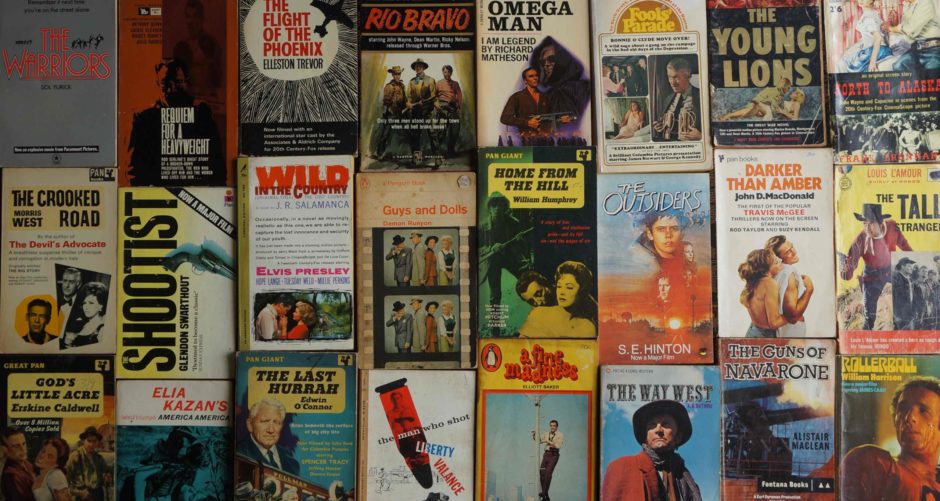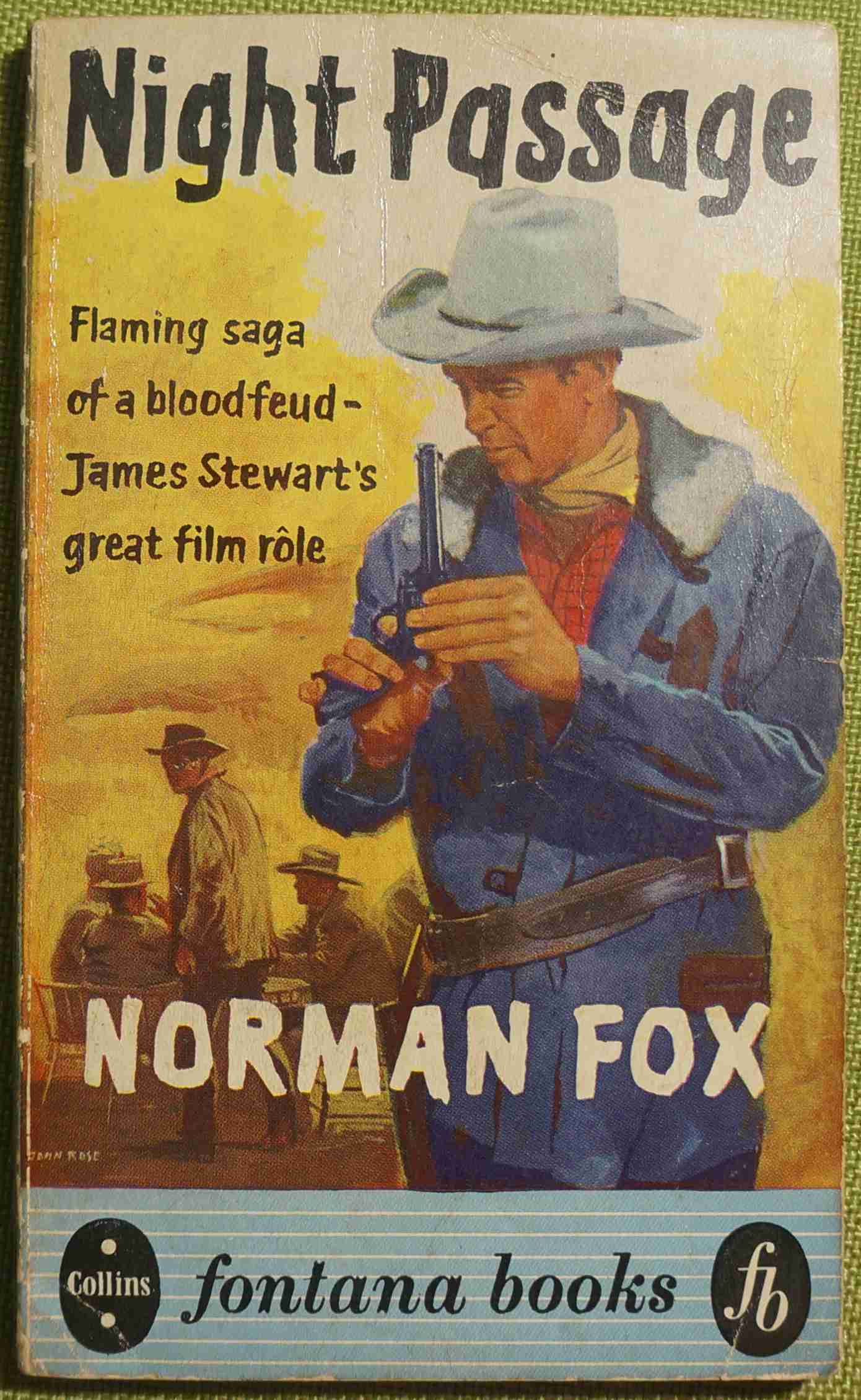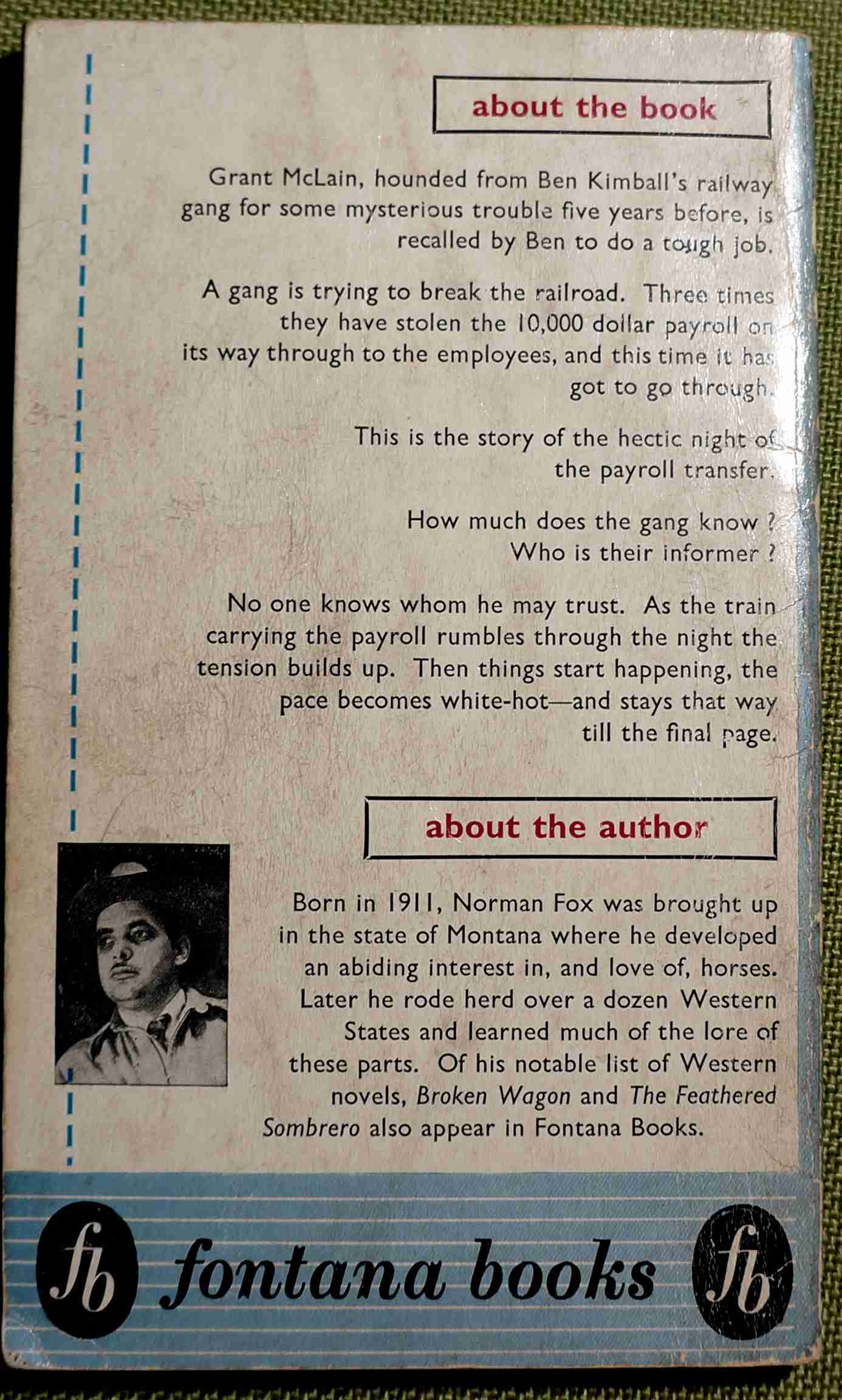FILM DIRECTOR: James Neilson
SCREENWRITER: Borden Chase
FILM STARS: James Stewart, Audie Murphy, Dan Duryea, Dianne Foster, Elaine Stewart, Brandon deWilde, Jay C. Flippen, Herbert Anderson, Robert J. Wilke, Hugh Beaumont, Jack Elam, Tommy Cook, Paul Fix, Olive Carey, James Flavin, Donald Curtis, Ellen Corby, John Daheim, Kenny Williams, Henry Wills, Chuck Roberson, Tommy Cook
COUNTRY: USA
THIS BOOK
AUTHOR: Norman Fox
TYPE: Novel
PUBLISHER: Fontana
THIS EDITION PUBLISHED: 1958
COUNTRY: Great Britain
COVER: Paperback
THE ORIGINAL BOOK
ORIGINAL AUTHOR: As Above
YEAR FIRST PUBLISHED: 1956
ORIGINAL BOOK TITLE: The film title
NOTES
GENRE: Western
WORDS: I have had the rare benefit of both reading this novel and re-watching this film withing short compass of each other recently.
So, similarities and dissimilarities between novel and film are fresh in mind.
And there are a few and they, if nothing else, indicate how novels are adapted for the screen to suit the needs of screenwriters, but also more importantly, the needs of producers, actors with star power and directors.
This film is usually described as “picturesque” but “routine”.
Yes, it is picturesque but within its limitations it is a superior entertainment.
Most of the criticism arises from the fact that the film was meant to be another pairing of director Anthony Mann and star James Stewart who were on a roll making some of the best westerns of the 1950 (Winchester ’73 (1950), Bend of the River (1952), The Naked Spur (1953), The Far Country (1954), and The Man from Laramie (1955)) as well as the non-westerns Thunder Bay (1953), The Glenn Miller Story (1954), Strategic Air Command (1955)).
Eight films in five years … and all hits. All, also, well regarded at the time and most highly regarded now.
Another Mann and Stewart western was considered a sure bet.
Mann signed on but pulled out before production began.
There are many reasons advanced but who knows what the true story is. Lazy assumptions are always made by armchair pop culture historians and even where there may be some evidence to support conclusions sometimes the reasons advanced are only one of many reasons … even if they come from the horse’s mouth. ie: What I say flippantly may be true or not, may be taken out of context, may be my response on a “bad hair” day, may be only part of a story, may be me looking for a reason, or may be someone’s interpretation of my words.
Worse still, sometimes, pop culture historians look for “exciting” reasons rather than humdrum ones.
Like any case a full interview with participants would settle it, failing that, several circumstantial facts all pointing to the same conclusion would have some weight.
Here, it’s suggested Anthony Mann pulled of the project because:
- He had obligations on other projects;
- He thought the script was weak;
- He disagreed over the casting of Audie Murphy;
- He fell out with Stewart who he felt was only making the film so he could play his accordion. Apparently, this enraged Stewart so much that the two didn’t speak again.
Where the truth is I don’t know, but,
- Perhaps there is some truth to other obligations as Night Passage was filmed Oct 1956 – Dec 1956 and Mann’s superior The Tin Star (1958) with Henry Fonda and Anthony Perkins which filming on and around Oct 22, 1956. There is also a suggestion, in a February 1956 HR news item (some 6 months before filming?) that he withdrew from the film to finish editing Men in War (1957) which he was co-producing (so had money in it). It’s hard to say at he was still filming that film around July 9, 1956.
- Yes, perhaps the script lacks the psychological intensity of Mann’s other westerns but only just. It was screen written by Borden Chase who also wrote Winchester ’73 (1950), Bend of the River (1952), The Far Country (1954) for Mann so I doubt that would have caused him to pull out. Chase gave him the framework for him to work his magic.
- Audie was a big star, and his role is relatively modest and against type (he clearly wanted to do the film and so accepted something smaller than normal) and Mann had worked with all sorts of personality actors in films so I doubt that disagreeing with Murphy’s casting would have been the main reason.
- Mann made eight films with Stewart before this and knew him, and no doubt his fondness for the accordion. Why leave?
I’ll take scheduling as the main reason for him pulling out (one film drags out, effects the next one, which effects the one that follows) but that’s never going to be as interesting as the other reasons.
Despite Mann leaving the film still works .. it is spectacular looking (much of it filmed on location in Silverton, Animas Canyon and Durango, Colorado) on the big screen at home but would be even better on the real big screen. It was one of the first produced in the Technirama widescreen process. Like VistaVision, the 35mm camera negative ran through the camera horizontally rather than vertically, exposing eight perforations-width frames rather than four perforations high, which made the image twice as sharp as CinemaScope, and other widescreen movies. Though in some theatres the large-frame negative was reduced to regular 35mm ‘scope prints”.
It was photographed by William Daniels who had done many films and had worked with Stewart a lot going back to the 1930s. He had also done Winchester ’73 (1950), Thunder on the Hill (1950), Thunder Bay (1952), The Glenn Miller Story (1953), The Far Country (1953), Strategic Air Command (1954) for Mann.
The script by Borden Chase excelled in the familial conflict and good vs evil westerns, most notably Red River (1948).
Director James Neilson was mainly a theatre and TV director, and this was his first film. With the team around him it comes off well though not distinctive. Neilson only did about 14 films mainly for Disney and a lot of television. Apparently, Stewart chose the director having been impressed with him when he worked with him on two (western) episodes of the anthology series General Electric Theater (The Windmill (1955) and The Town with a Past (1957))
I think the problem with the film is the script which feels a little truncated Some of the characters are a little underwritten or seem to have had motivation scenes cut. Normally I would say it is unlikely to be Borden Chase (given his form), and likely to be the result of producer tampering. Here the producer was Aaron Rosenberg and he, also has a proven track record with both Stewart and Mann (he produced Winchester ’73 (1950), Bend of the River (1952), Thunder Bay (1953), The Glenn Miller Story (1954), The Far Country (1954)) and Audie Murphy (producing Gunsmoke (1953), To Hell and Back (1955), World in My Corner (1956), Walk the Proud Land (1956), Joe Butterfly (1957)) as well as producing the good looking and thoughtful westerns The Man from the Alamo (1953), Saskatchewan (18954), Man Without a Star (1955), Backlash (1956), The Badlanders (1958).
Audie’s role (as the niftily named The Utica Kid) is quite small, and he isn’t nasty enough. He is more dark and edgy than in his normal roles which is great because knowing Audie’s history (personal, military and film) there is a darkness behind the boyish face which was rarely explored. It’s hinted here but that’s it. Worse still Stewart and Murphy are meant to be brothers …. they don’t seem to be born of the same mother in looks or in personality. Dan Duryea plays the villain here, a role he has played many times though here, he too seems to have a truncated role leaving only a lot of shouting. The female leads are marginal but rightly or wrongly they often were in these types of westerns (the more well-known Dorothy Malone had been cast but left the production after she was denied “preferred billing”). Brandon de Wilde as the kid is fine. Interestingly Paul Fix (John Wayne’s good friend and an occasional member of John Ford’s stock company) plays a railroader call Mr Feeney (director Ford’s real name) … a tribute perhaps? Ellen Corby (later of the Waltons) plays his wife. Robert J. Wilke and Jack Elam as henchmen are perfect.
The book is a solid western read. Author Norman Fox wrote around 30 westerns in 20 years. Coincidentally he wrote another novel Roughshod (1951) which became a western for Audie, Gunsmoke (1953).
He is well regarded if not highly regarded. The book here doesn’t have the psychological intensity I suspect the film was looking for, but it does have a lot of colour and detail. Fox’s stories were often set around actual events in Montana history and contained authentic detail for the period.
Whereas the film tries to concentrate on the story of two brothers on opposite sides of law (like Winchester ’73 (1950)) the novel fleshes out all the smaller characters around them that provide the backstory to their antagonism.
The story is tightened up for the film. There are subplots done away with, the female characters are reduced to posts the males can latch onto or launch off, so much so that in the film the character of Verna Kimball, who had a relationship with Stewart’s character, Grant McLaine (McLain in the book), is railroad camp head Ben Kimball’s wife in the book she is his daughter, with a fiancée from back east though that doesn’t stop her “using” Stewart. Likewise, the girl in love with Audie and Jimmy, “Charlie” Drew, spends much time in the book agonising over which brother to choose whereas in the film she flips pretty quickly. In the novel she had dated McLaine before the Utica kid took her away – no suggestion of that in the film. Otherwise, the action in the book (like the climactic gunfight in a saloon) is moved outdoors to make use of the location shooting.
The film also makes use of the actors’ personas … Stewart is a much more twitchy and neurotic (as he was in most Mann westerns) than the hero in the book, Dan Duryea’s Curly it more unhinged, Audie is more of a hero.
The film is not bad on its own terms and the book is a good late night read on a train, plane or bus.
LINKS
TRAILER
James Stewart and his accordion



yep re Kirk … no one pushes Kirk around. His Bryna Production Company was involved with (partially funded) POG ..and…